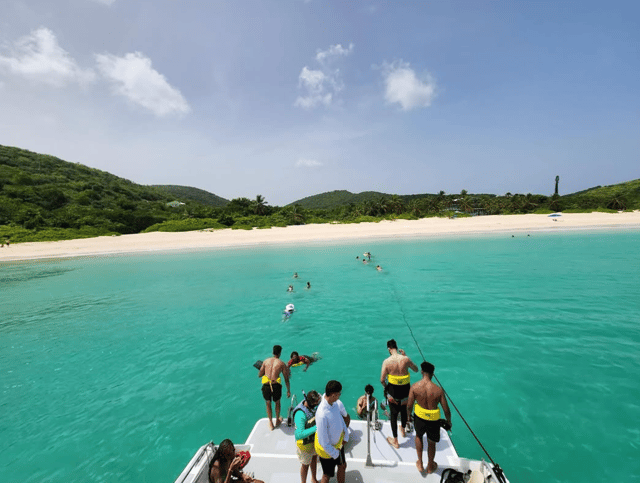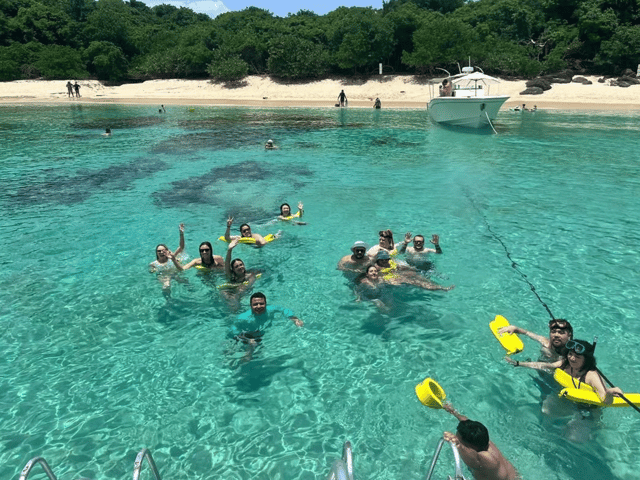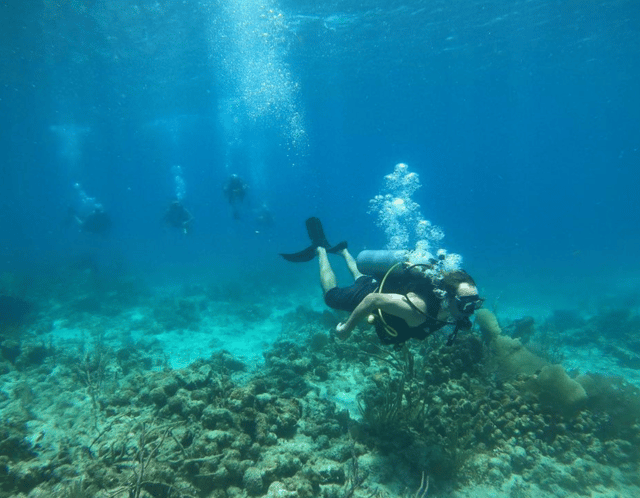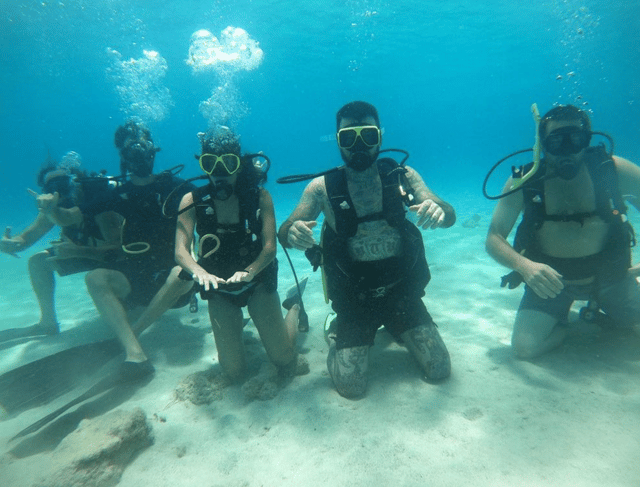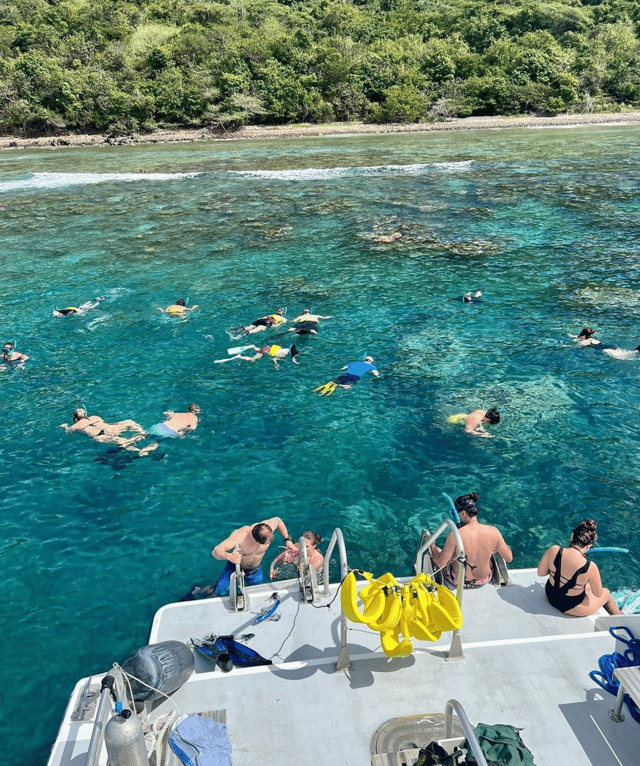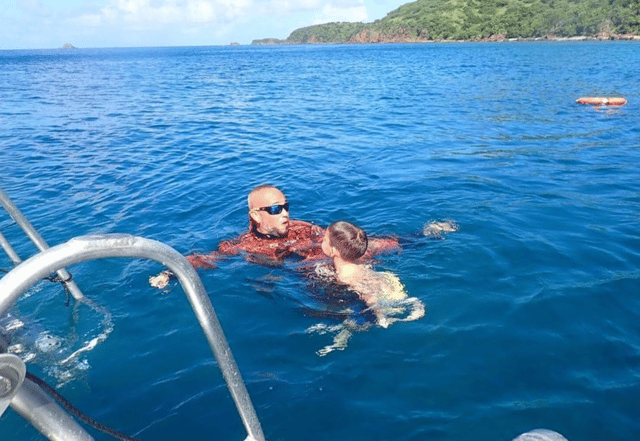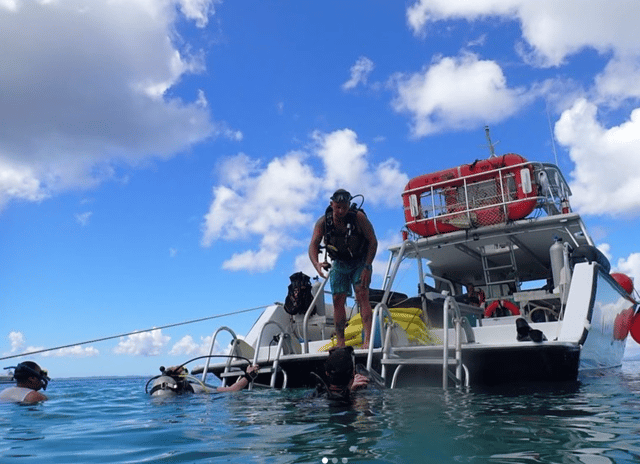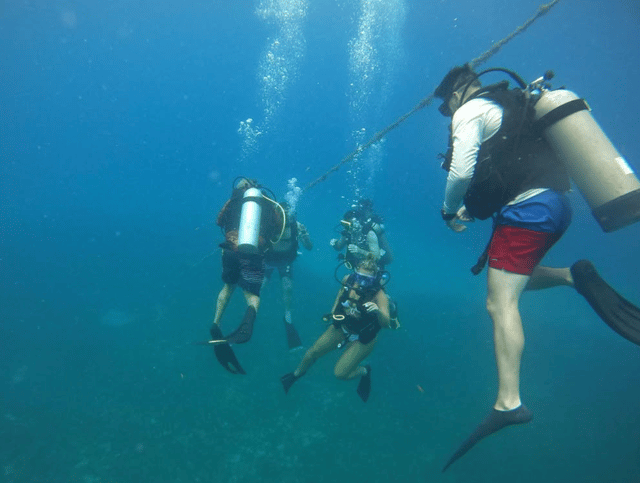Culebra Snorkel or Scuba Excursion
GuidedDuration: 6 hours
Features
Description
Choose your Adventure: Snorkeling or Scuba Diving at Culebra, Puerto Rico!
Duration of Adventure
- 6 hours
- The boat will depart Fajardo at 9:00 am and sail for approximately an hour to our first site where you will enjoy snorkeling some of the best reefs of Culebra. We will be at this first site for about 1 hour and 20 minutes.
- At around 1:40 pm we will head back to the marina, arriving at 3:00 pm.
Location / Where to Meet
- Check in/ Departure Address: Marina Lanais, 1000 Av. Acapulco, Las Croabas, Fajardo 00738, Puerto Rico
- Guests will be expected to arrive at Marina Lanais in Fajardo at 8:00 am where you will fill out waivers and get fitted with snorkeling equipment.
Ages & Requirements
- Minimum age of 10 years old in order to participate in scuba diving.
- Must be 3+ years old to be on the boat.
- Pregnant women are not allowed to participate on the tour.
- Must have a basic swimming ability
- If this trip does not reach 15 participants we will stay local in Fajardo and not travel to Culebra. If this occurs there will be a drop in price and you will receive a partial refund to the credit card used to reserve this trip.
- You will be required to complete a PADI Medical Questionnaire at Check-in. Presence of Health conditions listed on the Medical Statement will prevent participation without a doctor's consent.
- Certified divers will be doing a 2-tank dive, one in each location. Dives are guided by dive masters.
- Non-certified divers will get to snorkel on the first location, that way instructors can determine they are comfortable in the water. Then, they will get trained and do their full dive on the second site.
What’s Included
- Snorkel Gear (Mask, Snorkel, Fins)
- Experienced Guides & Certified Scuba Guides
- Flotation Life Vests
- Complimentary Water & Sodas
- You will be provided with a light lunch, cold cut sandwiches, fresh fruits, chips and dips.
- Discover Scuba includes all rental scuba equipment (BCDs, regulators, mask, fins, etc.).
- Certified divers get tanks, weights, and weight belts.
- DAN 02 Kits
- DAN First Aid Kit
Not Included
- Gratuity - Never expected but if you have a great experience, please consider gifting 10-25% to your guides and captains!
- If you need a prescription mask, please rent from a dive shop ahead of your tour time!
- Certified Divers can add on all rental scuba equipment (BCDs, regulators, mask, fins, etc.) for an extra fee.
What to Bring / Wear
- Swimsuit
- Towel
- Reef-Safe Sunscreen
- Extra Layers of Clothing - Sweatshirts and Warm Hats
- Dry bag
- Snacks & Water
- Certification Cards for certified divers.
- Required paperwork - Signed medical form if required, waivers, etc.
- Waterproof & Pressure Proof Camera (e.g. GoPros NEED the special DIVE case) - The company is not responsible for any damaged or lost items.
- Seasickness medications - If you are prone to seasickness, it is recommended to take sea sickness medication at least 30 minutes to 1 hour before the scheduled boat time. It is too late to take the medication if you are already seasick on the boat.
- Please remove any jewelry, watches, or anything that can get damaged by water or are items you don’t want to lose.
Wildlife Guidelines
Please be respectful of the fact that coral is a living organism and any standing, touching, or knocking over will irreparably damage the organism that takes a very long time to grow and is essential to our marine reefs. Please also be respectful of any marine animals including but not limited to turtles, rays, sharks, seals, and dolphins. Please never chase, harass, feed, or TOUCH any of the marine species. Enjoy their company if they approach from a distance and calmly move away from them if in their path.
ADVENTURE PROVIDED BY Casa Del Mar
FAQs
What kind of wildlife will we see?
The colorful reefs are filled with all kinds of marine life like turtles, lobster, blue tangs, stingrays, spotted eagle rays and more.
What is snorkeling? What is the difference between snorkeling and scuba diving?
Snorkeling is swimming with fins, a mask, and a tube called a snorkel that allows you to have your face down in the water and still breathe.
Snorkeling doesn’t require tanks or regulators. Scuba diving allows you to breathe underwater, while snorkeling allows you to breathe while you are on the surface with your face down. Snorkeling doesn’t require any certification, while scuba diving requires certification.
Is snorkeling safe?
One of the wonderful things about snorkeling is that people of all ages can participate. And one of the great things about Puerto Rico is that there are many great places for beginners to try it out.
Do I need to be a good swimmer?
Well, it sure can’t hurt, but it’s not required. It is recommended that you do have some comfort and experience when you are in water though. A few things to consider are that your fins help you a great deal in terms of movement, and they float. The mask that you wear has air trapped in it and helps you float as well. If you don’t feel safe enough, you can also use snorkeling belts to float, which are included on all our snorkeling tours.
What equipment do you need to snorkel?
There are three main things that most snorkelers use - all of these are included in the cost of your adventure.
- Mask: This allows you to see underwater without getting your eyes and nose wet. It’s important that the mask is a good fit when renting or buying. If the mask doesn’t fit well, you will experience some leakage of water in the mask. I would highly recommend using a mask that has a “silicon skirt.” The skirt is the soft substance that is molded to fit your face and prevents water from entering the mask. You can also rent or buy masks that use rubber as the skirt, but the seal is not nearly as good as the silicon and is quite simply a dated technology. Ask your local snorkel or dive shop about choosing a mask that fits well. They will know what to look for.
- Snorkel: This is what makes you a snorkeler. A snorkel is a hollow curved tube that is placed in the mouth and allows you to breathe while you are face down in the water. So basically, while you are looking down into the water, the other end of the snorkel is sticking out of the water.
- Fins: This is what makes life a lot of fun. Fins allow you to swim like a fish. Yeeehaw! There are two kinds of fins, but for snorkeling in warm water, most people will do just fine with the closed-heel kind. The open-heel kind is more for scuba divers, requiring a special boot (bootie), or for colder waters. Make sure that the fins are a good fit, or else you will either be cutting off circulation to your feet or they will easily come off. Make sure that they fit snugly, but you should be able to wiggle your toes.
How do I snorkel?
Our experienced guides will show you the ins-and-outs of snorkeling, but here is a brief overview: The first step is getting used to the mask. One thing to note about masks is that they tend to fog up. You can either apply anti-fog goop (available at the dive shop) to the inside of the mask, or you can use your own spit. It sounds gross, but spit works quite well for preventing the fogging up of your mask. Make sure that the spit/anti-fog goop is spread across the full surface of the glass on the inside of the mask. Now wash it out in the water. This should prevent, or at least greatly reduce, any fogging up of the mask.
When putting on the mask, make sure there are no hairs stuck in between the silicon part of the mask. Hair will break the seal that keeps the water from entering the mask. Also, keep the strap in the middle of the back of your head, and don’t have the strap too tight. Now, put your mask on and look underwater while you’re standing up. You’re looking underwater. No fish yet, but soon.
Next, attach the snorkel to your mask strap with the clip that’s on the snorkel. Put the snorkel in your mouth and breathe. Don’t try to breathe with your nose or else the mask will quickly fog up. Breathe through your mouth in relaxed, normal breaths. Now try breathing with your face in the water. Nothing to it, right? Take as long as you want to get used to breathing underwater. That’s the biggest mental hurdle for first-time snorkelers. Are you comfortable yet?
If so, put on your flippers and give it a try. With your face down and body stretched out, start kicking with your fins. Remember to keep your legs straight while you lightly kick. You don’t have to thrash around to swim well. Stay relaxed, and swim around the pool, getting used to breathing, kicking, and looking around.
Can you go underwater with a snorkel? What if I want to get close to marine life?
Although many snorkelers dive underwater, some people prefer not to. If you see a fish several feet below you and you want to get a closer look, you’ll have to dive down. By doing this, your snorkel will fill up with water, and you will not be able to breathe until you clear the passage of your snorkel of water once you have resurfaced. It sounds a bit iffy, but it’s a common thing for more experienced snorkelers to dive down and fill their snorkel with water.
To clear the snorkel of water, you must resurface, give a good strong blow of the snorkel as your head reaches the surface once again, and the top of the snorkel has penetrated the surface of the water. This should clear most if not all of the water that has filled the snorkel and allow you to breathe normally through the snorkel once again. Once you get comfortable doing this, you will feel more confident and will have a more positive, relaxed experience out on the reef.
What conditions are good for snorkeling?
The best time to go is when the waves are minimal and it’s sunny outside. Not only do large waves make things more challenging to get around and potentially dangerous, but a disturbance such as big waves also makes the water murky, greatly decreasing visibility. It’s also best to go snorkeling when the sun is out. Sunlight increases visibility and brings out the true colors of fish and coral. Our crews are great at finding the ideal snorkeling locations!
What sunscreen can I use and why does it matter?
Common sunscreens contain chemicals that can harm coral reefs, as the particles are small enough to be absorbed by corals, causing toxicity and coral bleaching. Reef-friendly sunscreens are formulated without these harmful chemicals. Reef-SAFE sunscreens go a step further by using non-nano particles, which are too large for corals to ingest, helping to preserve marine ecosystems.
Please avoid sunscreens with oxybenzone, octinoxate, and parabens. Consider wearing sun-protective clothing, like long-sleeve rash guards, as an alternative to sunscreen. If you choose a mineral-based sunscreen, ensure it is labeled ‘non-nano.’
Are there sharks?
Shark incidents in Puerto Rico’s waters are extremely rare, and serious injuries are even rarer. When you enter the ocean, it’s important to remember that it’s a natural, wild environment with many types of marine life, including sharks. Although the chances of a shark-related injury are very low, they are still part of the ocean’s ecosystem, and the ocean should be approached with respect. By learning about sharks and following safety guidelines, you can minimize even this small risk.
Can I snorkel if I wear glasses?
Standard eyeglasses can’t be worn with a snorkel mask, but prescription masks are available for those who need vision correction while snorkeling. If you’re interested, consider looking into a prescription mask option before your tour. Alternatively, contact lenses can be worn under a snorkel mask, though it’s best to close your eyes if water enters to prevent losing a lens.
What's included with scuba diving?
All of the dives we offer include tanks, weights, and weight belts. In addition, the following items are available to make your dives more enjoyable at no additional charge:
On board the boats:
- Ice chest with ice
- Fresh water, refreshments, fruits, chips and salsa
- Towels
- Full day trips include lunch
- DAN 02 Kits
- DAN First Aid Kit
On the docks:
- Gear rinse tanks
- Overnight gear storage rooms
How do you mix beginners and advanced divers?
All boats with divers have a minimum of two crew members. One is an in-water Divemaster and the other crew member remains on board to assist divers. On both dives, we have a Divemaster in the water to assist other divers and to lead portions of the dive.
We respect the effort you put into earning your certification card and respect the qualifications you earned. As such, we expect that all divers who present themselves as certified divers are capable of executing and successfully navigating a dive as a buddy team without any assistance from an in-water Divemaster. However, for your convenience and peace of mind, we have a divemaster in the water all the time to assist you and guide and navigate your dive for you.
All of our dives start with a briefing, where our Divemaster shares with you a description of the site, local area, environment, and emergency procedures. Divers who are experienced and comfortable with their own navigation are welcome to go off on their own. During the dive briefing, a suggested profile is described along with a return time. If you perform your own navigation, all we ask is that you are back on the boat by the specified return time.When possible, we try to separate divers by experience levels and offer two options, a more experienced boat trip and a beginner diver trip for divers who are new or have not been in the water for an extended period of time.
What are the water conditions like?
Puerto Rico, especially the east side of the island where we are located, enjoys great water conditions year round. Because of our geographic location, we have many cays which protect our dive sites from rough waters. Water visibility can vary dramatically depending on wind and rain. Average visibility is about 40 to 50 ft (12 to 15 m) and can go up to 100 ft (30.5 m).
The water temperature changes seasonally. Our seasons are just the same as they are in the United States, with the winter months being colder than summer. A rough breakdown of water temperatures would be as follows:
- January-March: 74 – 76 degree, 3mm suit
- April-May: 75 – 78 degrees, 3mm suit
- June-August: 80 – 85 degrees, no wetsuit required
- September-October: 78 – 80 degrees, 1mm-3mm suit
- November: 78 – 74 degrees, 3mm suit
- December: 74 – 78 degrees, 3mm suit
As always, you should base your thermal protection needs on your sensitivity, the number of dives you are going to perform each day, and the number of repetitive diving days you plan to participate in.
Can I fly after diving?
Flying directly after scuba diving is incredibly dangerous and could result in a life-threatening illness called the Bends/Decompression Sickness. The Divers Alert Network (DAN) guidelines for flying after diving include:
- A single no-decompression dive, a minimum preflight surface or any driving to above 1000 ft (305 m) interval of 12 hours suggested.
- Multiple dives per day or multiple days of diving, a minimum preflight surface or any driving to above 1000ft (305m) interval of 18 hours is suggested.
- Dives requiring decompression stops are recommended to have longer than 18 hours.
Please discuss with your dive guide ahead of time what is suggested!
Can I go hiking after diving?
Any activity that brings you above 1000 ft (305 m) can trigger the Bends/Decompression Sickness. Please check your hike elevation to ensure that at no time you will be going up in elevation. If the hike does go to elevation, you must treat it like a preflight interval as listed above in the flying FAQ.
Cancellation Policy
Upon confirming a tour, we reserve a space for you and coordinate personnel, equipment, transportation and others to provide you with the best service.
- Notifications of any changes to your tour, including a cancellation, must be made by 6:00pm the day before your tour to avoid any penalties.
-If you do not show up on the day of your tour you will be charged in full for the particular activity you booked. - If we receive a cancelation on the same day of the tour you will be charged 100% of the tour.
- No shows, not completing the tour or cancelling on site will result in 100% charge of the tour.
- Basic swimming ability is required for all tours with the exception of Sea Trek. If not knowing how to swim becomes an impediment to complete the tour, you will still be charged 100% the cost of the tour.
- Sea Trek tour requires to be at least 8 years old and weight at least 80 pounds.
Aqua Adventure will not penalize you for sudden cancelations due to severe ocean/weather conditions. Cancelations due to weather will be determined by Aqua Adventure only. - Note: It is highly recommended that all participants arrive to the tour sites ready to enter the water by wearing their bathing suits underneath their clothing. This will prevent delays in the organization of our tours
Availability
Reviews
Location
Address
Isleta Marina Ferry
Fajardo, PR, 00740
PR
ASK THE LOCAL EXPERT
✔️Best price guarantee - book direct with the outfitter
✔️Trusted local outfitters, vetted for quality
✔️Free cancellation on most adventures
Discover 5,000+ handpicked human powered adventures.
Book directly with vetted local experts.
Average 4.8 ⭐️ across 185,000 reviews.
Every booking contributes to conservation.
Proud member of The Conservation Alliance and Leave No Trace.
